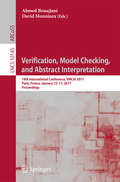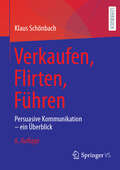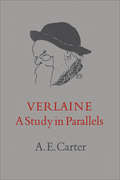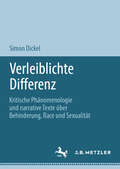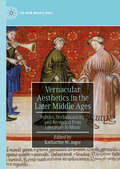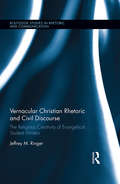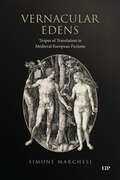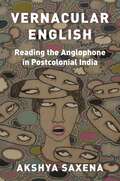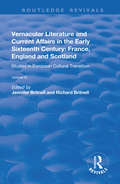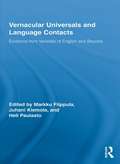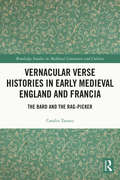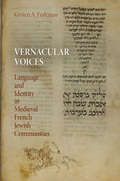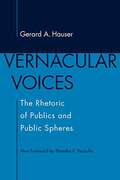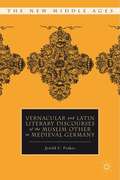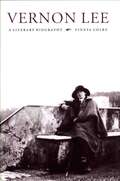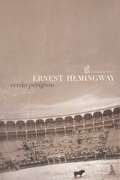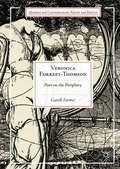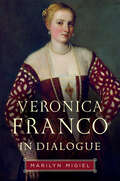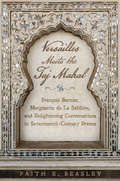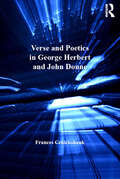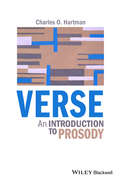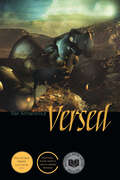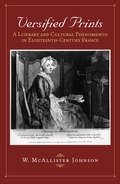- Table View
- List View
Verification, Model Checking, and Abstract Interpretation
by Ahmed Bouajjani David MonniauxThis book constitutes the refereed proceedings of the 18th International Conference on Verification, Model Checking, and Abstract Interpretation, VMCAI 2017, held in Paris, France, in January 2017. The 27 full papers together with 3 invited keynotes presented were carefully reviewed and selected from 60 submissions. VMCAI provides topics including: program verification, model checking, abstract interpretation and abstract domains, program synthesis, static analysis, type systems, deductive methods, program certification, debugging techniques, program transformation, optimization, hybrid and cyber-physical systems.
Verkaufen, Flirten, Führen: Persuasive Kommunikation – ein Überblick
by Klaus SchönbachWie und warum gelingt es uns, andere davon zu überzeugen, etwas zu kaufen, uns zu helfen, sich (ver)führen zu lassen? Und was können wir dafür von der Werbung lernen? Ein umfassender Überblick über die Erkenntnisse zur persuasiven Kommunikation - von einem der auch international bekanntesten deutschen Kommunikationswissenschaftler, auf der Erfahrung mit Forschung, Seminaren, Vorlesungen und Kursen aus mehr als 40 Jahren aufgebaut und auf dem neuesten Stand der Wissenschaft. Praktisch, aber mit gründlichem theoretischen Hintergrund. Mit allen Quellenangaben zum Weiterlesen. Für die sechste Auflage wurde der Band aktualisiert und überarbeitet.
Verlaine: A Study in Parallels
by A. E. CarterThe contradictions of Verlaine's nature are mirrored in his verse, which is alternately mystic, sensuous, exquisite and prosaic. He had extraordinary lyric powers; he was a master of eerie harmonies such as few other poets have achieved, and, in Sagesse, he produced religious verse which challenges comparison with the very best of its kind. Yet here and there can be found a curious weakening in the texture of thought and inspiration: he turns and twists, takes flight, seeks reassurance in platitude and convention – marriage, dogmatic theology, reactionary political creeds. He is even capable of lamenting (as Rimbaud shows him in Une Saison en Enfer) the emotional and poetic experiments which give his work its supreme value. It is almost as though he were afraid of his own talent. The explanation, as far as there is one, lies in a combination of personality and circumstance. This biography attempts to explore the "parallels" (Verlaine's own term) between his life and his poetry. Nearly everything he produced, whether good or bad, was a reflection of some crisis of thought or feeling. No one demonstrates better than Verlaine the antinomies between the artist and his work, between the man and the genius; and in every case we are obliged to admit that the one explains the other. Without the weakness and the squalor we might indeed have had a rational human being and a good husband for Mathilde Mauté, but we should have had no poet, or no poet like Paul Verlaine. Professor Carter concentrates on the combination of Verlaine's personality and experiences that produced some of the most brilliant poetry in the French language. The result is one of the best critical biographies of Verlaine published to date.
Verleiblichte Differenz: Kritische Phänomenologie und narrative Texte über Behinderung, Race und Sexualität
by Simon DickelDieses Buch untersucht, wie phänomenologische Ansätze zu den Themen Verleiblichung, Wahrnehmung und gelebte Erfahrung innerhalb der Disability Studies, der Critical Race Theory und der Queer Studies diskutiert werden. Auf Grundlage dieser Disziplinen analysiert der Autor Autobiografien und Romane, die sich mit den Folgen von Stigmatisierung und den körperlichen Dimensionen sozialer Ungleichheit auseinandersetzen. Die untersuchten Texte sind Robert F. Murphys The Body Silent, Simi Lintons My Body Politic, Rod Michalkos The Two-in-One: Walking with Smokie, Walking with Blindness, drei autobiografische Texte von Stephen Kuusisto, Vincent O. Carters The Bern Book sowie zwei Romane, Matthew Griffin's Hide und Armistead Maupin's Maybe the Moon. All dieseTexte haben die Bedeutung von Körpergedächtnis und Wahrnehmungsgewohnheiten, den Einfluss von Sprache und Kultur für Prozesse der Verleiblichung, die Bedeutung von Relationalität und Gemeinschaft,die Auswirkungen von Beleidigung und Nichtanerkennung sowie Emanzipation und soziale Anerkennung zum Thema. Folglich werden sie als bahnbrechende Beiträge zur kritischen Phänomenologie diskutiert.
Vernacular Aesthetics in the Later Middle Ages: Politics, Performativity, and Reception from Literature to Music (The New Middle Ages)
by Katharine W. JagerVernacular Aesthetics in the Later Middle Ages explores the formal composition, public performance, and popular reception of vernacular poetry, music, and prose within late medieval French and English cultures. This collection of essays considers the extra-literary and extra-textual methods by which vernacular forms and genres were obtained and examines the roles that performance and orality play in the reception and dissemination of those genres, arguing that late medieval vernacular forms can be used to delineate the interests and perspectives of the subaltern. Via an interdisciplinary approach, contributors use theories of multimodality, translation, manuscript studies, sound studies, gender studies, and activist New Formalism to address how and for whom popular, vernacular medieval forms were made.
Vernacular Christian Rhetoric and Civil Discourse: The Religious Creativity of Evangelical Student Writers (Routledge Studies in Rhetoric and Communication)
by Jeffrey M. RingerVernacular Christian Rhetoric and Civil Discourse seeks to address the current gap in American public discourse between secular liberals and religiously committed citizens by focusing on the academic and public writing of millennial evangelical Christian students. Analysis of such writing reveals that the evangelical Christian faith of contemporary college students—and the rhetorical practice motivated by it—is marked by an openness to social context and pluralism that offers possibilities for civil discourse. Based on case studies of evangelical Christian student writers, contextualized within nationally-representative trends as reported by the National Study of Youth and Religion, and grounded in scholarship from rhetorical theory, composition studies, folklore studies, and sociology of religion, this book offers rhetorical educators a new terministic screen that reveals the complex processes at work within our students’ vernacular constructions of religious faith.
Vernacular Edens: Tropes of Translation in Medieval European Fictions
by Simone MarchesiLate-medieval European vernacular literature defined itself as the redeployment of classical and post-classical antecedents in new cultural coordinates. Many authors of narrative and poetic fiction between the twelfth and fourteenth centuries resisted the idea that moving a text from one language to another produces a loss of meaning, or, as today’s idiom goes, that something always gets “lost in translation.” Rather, they understood the process of vernacular translation as a regenerative cultural practice and often associated it with depictions of luscious and paradisal gardens in their works. Vernacular Edens presents a systematic study of a literary commonplace, the representation of gardens in medieval fictions, as a lens to understand the theories and practices of translation from Latin to the vernaculars. The book argues that the prominent narrative space that works composed in Old French, Italian, and Middle English give to garden-visit scenes is connected to their vindication of translation as an always-enriching practice. A wide range of texts from Marie de France’s Lais to the Roman de la Rose, from Dante’s Comedy to Boccaccio’s Decameron, and from Petrarch’s Griselda to Chaucer’s Clerk’s and Merchant’s Tales provide the body of evidence analysed in the book.
Vernacular English: Reading the Anglophone in Postcolonial India (Translation/Transnation #45)
by Akshya SaxenaHow English has become a language of the people in India—one that enables the state but also empowers protests against itAgainst a groundswell of critiques of global English, Vernacular English argues that literary studies are yet to confront the true political import of the English language in the world today. A comparative study of three centuries of English literature and media in India, this original and provocative book tells the story of English in India as a tale not of imperial coercion, but of a people’s language in a postcolonial democracy.Focusing on experiences of hearing, touching, remembering, speaking, and seeing English, Akshya Saxena delves into a previously unexplored body of texts from English and Hindi literature, law, film, visual art, and public protests. She reveals little-known debates and practices that have shaped the meanings of English in India and the Anglophone world, including the overlooked history of the legislation of English in India. She also calls attention to how low castes and minority ethnic groups have routinely used this elite language to protest the Indian state.Challenging prevailing conceptions of English as a vernacular and global lingua franca, Vernacular English does nothing less than reimagine what a language is and the categories used to analyze it.
Vernacular Literature and Current Affairs in the Early Sixteenth Century: France, England and Scotland (Studies In European Cultural Transition Ser. #6)
by Jennifer BritnellThis title was first published in 2000: The printed writings of the most important authors of the sixteenth century are characterised by frequent references to current affairs. This collection brings together essays by literary scholars and historians of the era to discuss various ways in which those writing in the vernacular during the early sixteenth century responded to contemporary events. The papers in this volume also demonstrate how the spread of literacy was of fundamental significance for the economics of book production, and for ways in which political power was exercised and expressed, as well as for the development of new literary forms of critical and occasional writing.
Vernacular Translation in Dante's Italy: Illiterate Literature
by Alison CornishTranslation and commentary are often associated with institutions and patronage; but in Italy around the time of Dante, widespread vernacular translation was mostly on the spontaneous initiative of individuals. While Dante is usually the starting point for histories of vernacular translation in Europe, this book demonstrates that The Divine Comedy places itself in opposition to a vast vernacular literature already in circulation among its readers. Alison Cornish explores the anxiety of vernacularization as expressed by translators and contemporary authors, the prevalence of translation in religious experience, the role of scribal mediation, the influence of the Italian reception of French literature on that literature, and how translating into the vernacular became a project of nation-building only after its virtual demise during the Humanist period. Vernacular translation was a phenomenon with which all authors in thirteenth- and fourteenth-century Europe - from Brunetto Latini to Giovanni Boccaccio - had to contend.
Vernacular Universals and Language Contacts: Evidence from Varieties of English and Beyond (Routledge Studies in Germanic Linguistics)
by Markku Filppula Juhani Klemola Heli PaulastoIn this book, contributors have been brought together to discuss the role of two major factors shaping the grammars of different varieties of English (and of other languages) all over the world: so-called vernacular universals and contact-induced change. Rather than assuming a general typological perspective, the studies in this volume focus on putative universal vernacular features – significant phonological or (morpho-) syntactic parallels found in non-standard varieties of English, English-based Creoles, and also varieties of other languages, all of which represent widely differing sociolinguistic and historical backgrounds. These universals are then set against the other major explanatory factor: contact-induced change, by which we understand both the possibility of dialect contact (or dialect diffusion) and language contact (including superstratal, substratal and adstratal influences).
Vernacular Verse Histories in Early Medieval England and Francia: The Bard and the Rag-picker
by Catalin TaranuIn a provocative take on Germanic heroic poetry, Taranu reads texts like Beowulf, Maldon, and the Waltharius as participating in alternative modes of history-writing that functioned in a larger ecology of narrative forms, including Latinate Christian history and the biblical epic. These modes employed the conceit of their participating in a tradition of oral verse for a variety of purposes: from political propaganda to constructing origin myths for early medieval nationhood or heroic masculinity, and sometimes for challenging these paradigms. The more complex of these historical visions actively meditated on their own relationship to truthfulness and fictionality while also performing sophisticated (and often subversive) cultural and socio-emotional work for its audiences. By rethinking canonical categories of historiographical discourse from within medieval textual productions, Vernacular Verse Histories in Early Medieval England and Francia: The Bard and the Rag-Picker aims to recover a part of the wide array of narrative poetic forms through which medieval communities made sense of their past and structured their socio-emotional experience.
Vernacular Voices: Language and Identity in Medieval French Jewish Communities (Jewish Culture and Contexts)
by Kirsten A. FudemanA thirteenth-century text purporting to represent a debate between a Jew and a Christian begins with the latter's exposition of the virgin birth, something the Jew finds incomprehensible at the most basic level, for reasons other than theological: "Speak to me in French and explain your words!" he says. "Gloss for me in French what you are saying in Latin!" While the Christian and the Jew of the debate both inhabit the so-called Latin Middle Ages, the Jew is no more comfortable with Latin than the Christian would be with Hebrew. Communication between the two is possible only through the vernacular.In Vernacular Voices, Kirsten Fudeman looks at the roles played by language, and especially medieval French and Hebrew, in shaping identity and culture. How did language affect the way Jews thought, how they interacted with one another and with Christians, and who they perceived themselves to be? What circumstances and forces led to the rise of a medieval Jewish tradition in French? Who were the writers, and why did they sometimes choose to write in the vernacular rather than Hebrew? How and in what terms did Jews define their relationship to the larger French-speaking community?Drawing on a variety of texts written in medieval French and Hebrew, including biblical glosses, medical and culinary recipes, incantations, prayers for the dead, wedding songs, and letters, Fudeman challenges readers to open their ears to the everyday voices of medieval French-speaking Jews and to consider French elements in Hebrew manuscripts not as a marginal phenomenon but as reflections of a vibrant and full vernacular existence. Applying analytical strategies from linguistics, literature, and history, she demonstrates that language played a central role in the formation, expression, and maintenance of medieval Jewish identity and that it brought Christians and Jews together even as it set them apart.
Vernacular Voices: The Rhetoric of Publics and Public Spheres (Studies in Rhetoric & Communication)
by Gerard A. Hauser Phaedra C. PezzulloA foundational text of twenty-first-century rhetorical studies, Vernacular Voices addresses the role of citizen voices in steering a democracy through an examination of the rhetoric of publics. Gerard A. Hauser maintains that the interaction between everyday and official discourse discloses how active members of a complex society discover and clarify their shared interests and engage in exchanges that shape their opinions on issues of common interest. <p><p> In the two decades since Vernacular Voices was first published, much has changed: in the aftermath of the 9/11 terrorist attacks, US presidents have increasingly taken unilateral power to act; the internet and new media have blossomed; and globalization has raised challenges to the autonomy of nation states. In a new preface, Hauser shows how, in an era of shared, global crises, we understand publics, how public spheres form and function, and the possibilities for vernacular expressions of public opinion lie at the core of lived democracy. A foreword is provided by Phaedra C. Pezzullo, associate professor of communication at the University of Colorado Boulder.
Vernacular and Latin Literary Discourses of the Muslim Other in Medieval Germany
by Jerold C. FrakesLittle attention has been focused onthe representation of Muslimsin medieval Germany. Proceeding from a grounded use of contemporary cultural theory and close textual analysis, this study analyzes the role of Muslims in several core texts representing drama, epic, and lyric written by the most important writers of medieval Germany. Far from simply adding medieval Germany to the growing scholarly list of the 'pre-post-colonializing' European cultures, this study provides importantnew perspectives. "
Vernon Lee: A Literary Biography
by Vineta ColbyVernon Lee, born Violet Paget in 1856 to English parents who lived on the Continent, bridged two worlds and many cultures. She was a Victorian by birth but lived into the second quarter of the twentieth century. Her chosen home was Italy, but she spent part of every year in England, where she published over the years an impressive number of books: novels, short stories, travel essays, studies of Italian art and music, psychological aesthetics, polemics. She was widely recognized as a woman of letters and moved freely in major literary and social circles, meeting and at times having close friendships with a huge number of the major writers and intellectuals of her time, among them Robert Browning, Walter Pater, Henry James, H. G. Wells, Bertrand Russell, Bernard Berenson, and Mario Praz. Although she never committed herself to one program of political activism, she was an advocate for feminism and social reform and during World War I was an ardent pacifist. In her last years she watched with dismay the emergence of fascism.Vernon Lee: A Literary Biography recovers this crowded and intellectually eventful life from her previously unpublished letters and journals, as well as from her books themselves. Vineta Colby also explores Lee's troubled personal life, from her childhood in an eccentric expatriate family to her several unhappy love affairs with women to her frank recognition that her work, brilliant as some of it was, remained unappreciated. Through it all, Vernon Lee clung to her faith in the life of the mind, and through Colby's engaging biographical narrative, she emerges today as a writer worthy of renewed attention and admiration.Victorian Literature and Culture Series
Veronica Forrest-Thomson
by Gareth FarmerThis study offers a comprehensive examination of the work of the young poet and scholar, Veronica Forrest-Thomson (1947-1975) in the context of a literary-critical revolution of the late sixties and seventies and evaluates her work against contemporary debates in poetry and poetics. Gareth Farmer explores Forrest-Thomson's relationship to the conflicting models of literary criticism in the twentieth century such as the close-reading models of F. R Leavis and William Empson, postructuralist models, and the work of Ludwig Wittgenstein. Written by the leading scholar on Forrest-Thomson's work, this study explores Forrest-Thomson's published work as well as unpublished materials from the Veronica Forrest-Thomson Archive. Drawing on close readings of Forrest-Thomson's writings, this study argues that her work enables us reevaluate literary-critical history and suggests new paradigms for the literary aesthetics and poetics of the future.
Veronica Franco in Dialogue (Toronto Italian Studies)
by Marilyn MigielSince the late twentieth century, the Venetian courtesan Veronica Franco has been viewed as a triumphant proto-feminist icon: a woman who celebrated her sexuality, an outspoken champion of women and their worth, and an important intellectual and cultural presence in sixteenth-century Venice. In Veronica Franco in Dialogue, Marilyn Migiel provides a nuanced account of Franco’s rhetorical strategies through a close analysis of her literary work. Focusing on the first fourteen poems in the Terze rime, a collection of Franco’s poems published in 1575, Migiel looks specifically at back-and-forth exchanges between Franco and an unknown male author. Migiel argues that in order to better understand what Franco is doing in the poetic collection, it is essential to understand how she constructs her identity as author, lover, and sex worker in relation to this unknown male author. Veronica Franco in Dialogue accounts for the moments of ambivalence, uncertainty, and indirectness in Franco’s poetry, as well as the polemicism and assertions of triumph. In doing so, it asks readers to consider their ideological investments in the stories we tell about early modern female authors and their cultural production.
Versailles Meets the Taj Mahal: François Bernier, Marguerite de la Sablière and Enlightening Conversations in Seventeenth-Century France
by Faith E. BeasleyVersailles Meets the Taj Mahal identifies and explores the traces that exposure to India left on the cultural artifacts and mindset of France’s "Great Century" and the early Enlightenment. Focusing on the salon of Marguerite de La Sablière and its encounter with the traveler and philosopher François Bernier, this book resurrects the conversations about India inspired by Bernier’s travels and inscribed in his influential texts produced in collaboration with La Sablière’s salon. The literary works, correspondences, and philosophical texts produced by the members of this eclectic salon bear the traces of this engagement with India. Faith E. Beasley’s analysis of these conversations reveals France’s unique engagement with India during this period and challenges prevailing images derived from a nineteenth-century "orientalism" imbued with colonialism. The India encountered in La Sablière’s salon through Francois Bernier and others is not the colonized India that has come to dominate any image of the Orient. Versailles Meets the Taj Mahal adds a new chapter to literary and cultural history by adopting a new approach to the study of salon culture, exploring how texts, cultural artifacts, and patterns of thought were shaped by the collective reading and by the conversations emanating from these practices. Beasley’s analysis highlights the unique role of French salon culture in the evolution of western thought during the early modern period.
Verse and Poetics in George Herbert and John Donne
by Frances CruickshankInnovative and highly readable, this study traces George Herbert's and John Donne's development of a distinct poetics through close readings of their poems, references to their letters, sermons, and prose treatises, and to other contemporary poets and theorists. In demonstrating a relationship between poetics and religious consciousness in Donne's and Herbert's verse, Frances Cruickshank explores their attitudes to the cultural, theological, and aesthetic enterprise of writing and reading verse. Cruickshank shows that Donne and Herbert regarded poetry as a mode not determined by its social and political contexts, but as operating in and on them with its own distinct set of aesthetic and intellectual values, and that ultimately, verse mattered as a privileged mode of religious discourse. This book is an important contribution to the ongoing scholarly dialogue about the nature of literary and cultural study of early modern England, and about the relationship between the writer and the world. Cruickshank confirms Donne's reputation as a fascinating and brilliant poetic figure while simultaneously rousing interest in Herbert by noting his unique merging of rusticity and urbanity and tranquility and uncertainty, allowing the reader to enter into these poets' imaginative worlds and to understand the literary genre they embraced and then transformed.
Verse and Virtuosity
by Janie SteenWhile there is little evidence of formal rhetorical instruction in Anglo-Saxon England, traditional Old English poetry clearly shows the influence of Latin rhetoric. Verse and Virtuosity demonstrates how Old English poets imitated and adapted the methods of Latin literature, and, in particular, the works of the Christian Latin authors they had studied at school. It is the first full-length study to look specifically at what Old English poets working in a Latinate milieu attempted to do with the schemes and figures they found in their sources.Janie Steen argues that, far from sterile imitation, the inventiveness of Old English poets coupled with the constraints of vernacular verse produced a vital and markedly different kind of poetry. Highlighting a selection of Old English poetic translations of Latin texts, she considers how the translators responded to the challenge of adaptation, and shows how the most accomplished, such as Cynewulf, absorb Latin rhetoric into their own style and blend the two traditions into verse of great virtuosity. With its wide-ranging discussion of texts and rhetorical figures, this book can serve as an introduction to Old English poetic composition and style. Verse and Virtuosity, will be of considerable interest to Anglo-Saxonists, linguists, and those studying rhetorical traditions.
Verse: An Introduction to Prosody (Princeton Legacy Library #2809)
by Charles O. HartmanVerse is a seminal introduction to prosody for any student learning to read or write poetry, from secondary to graduate school. Discusses iambic pentameter and other kinds of metrical verse, scansion, rhythm and rhyme, free verse, song, and advanced topics such as poetic meter, linguistic approaches to verse, and the computer scansion of metrical poetry Written in a clear, engaging style by a poet and teacher with more than 30 years of experience teaching the subject Supplemented by a user-friendly website with student exercises and additional resources
Versed (Wesleyan Poetry Series)
by Rae ArmantroutWinner of the 2010 Pulitzer Prize for PoetryWinner of the Pulitzer Prize for Poetry (2010)Winner of the National Book Critics Circle Award (2009) Rae Armantrout has always organized her collections of poetry as though they were works in themselves. Versed brings two of these sequences together, offering readers an expanded view of the arc of her writing. The poems in the first section, Versed, play with vice and versa, the perversity of human consciousness. They flirt with error and delusion, skating on a thin ice that inevitably cracks: "Metaphor forms / a crust / beneath which / the crevasse of each experience." Dark Matter, the second section, alludes to more than the unseen substance thought to make up the majority of mass in the universe. The invisible and unknowable are confronted directly as Armantrout's experience with cancer marks these poems with a new austerity, shot through with her signature wit and stark unsentimental thinking. Together, the poems of Versed part us from our assumptions about reality, revealing the gaps and fissures in our emotional and linguistic constructs, showing us ourselves where we are most exposed. A reader's companion is available at http://versedreader.site.wesleyan.edu/
Versified Prints
by W. Mcallister JohnsonThe term 'versified prints' is used to describe images that are accompanied by poetic explanatory text. They were immensely popular and diffused throughout Europe in the eighteenth century, and many were shown at the Salon du Louvre. Although not all print verses are signed, their authors include occasional poets and members of the Académie Française. These prints remain among the most accessible documents for the study of art and society, but have never been examined before for their historical and cultural context.With 112 full-page reproductions, Versified Prints offers an engaging and informative introduction to these intriguing works. W. McAllister Johnson's guide discusses print production, the nature of sources, and the relationship and transformations in both text and images. Proposing a typology and methodology for this artistic phenomenon, Versified Prints enhances our knowledge of this fascinating new area of research and lays the groundwork for future studies. Disclaimer: Images removed at the request of the rights holder.
